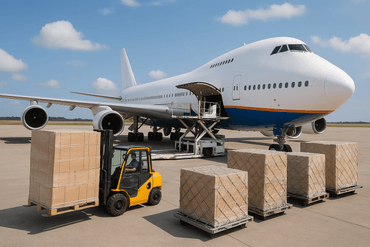
Import from India: Shipping tips



As one of the most important emerging markets in the world, opportunities to do business with India abound.
It’s currently the fourth-largest economy in the world and the 17th largest export economy with exports continuing to grow annually. Its GDP is also on a near-exponential increase, marking a 46.8 percent growth from $1.86 trillion to $2.73 trillion in the five-year period from 2013 to 2018.
More recently, its economy grew at its slowest rate in six years. Even then, it still registered a 4.7 percent in the quarter ending in September 2019.
Import from India: Top products imported by buyers worldwide
In 2017, the South Asian country exported $292 billion worth of goods, with chemical products, precious metals, and textiles as its three most exported products. At 14 percent, 13 percent, and 13 percent respectively, these goods form 40 percent of all products imported from India.
Here’s a breakdown of the top five products in each category.
Chemical products
Packaged medicaments: $13.2 billion (4.5% of value of total exports)
Nitrogen heterocyclic compounds: $2.94 billion (1.0%)
Synthetic coloring matter: $2.23 billion (0.76%)
Cyclic hydrocarbons: $2.2 billion (0.75%)
Pesticides: $1.5 billion (0.51%)
Precious metals
Diamonds: $26.5 billion (9.1%)
Jewelry: $8.66 billion (3.0%)
Gold: $2.27 billion (0.78%)
Precious stones: $618 million (0.21%)
Precious metal scraps: $458 million (0.16%)
Textiles
- Non-retail pure cotton yarn: $3.35 billion (1.1%)
- Non-knit women’s suits: $2.61 billion (0.89%)
- Knit T-shirts: $2.57 billion (0.88%)
- House linens: $2.21 billion (0.75%)
- Non-knit women’s shirts: $1.99 billion (0.68%)
Tips to help with your import from India into the US
The potential to do business and grow and scale in India is certainly something that buyers in the United States are not only aware of but are also capitalizing on.
The US is currently India’s top trading partner, with around $51.6 billion worth of Indian exports traveling nearly halfway across the globe to the US. That makes up 16 percent of total exports from India and more than the combined value of exported goods to India’s second-, and third-largest trading partners, the United Arab Emirates (9 percent) and China (5.1 percent) respectively.
Of the imported goods from India to the US, chemical products, precious metals, and textiles make up 20 percent, 19 percent, and 16 percent respectively — more than half of the total value of goods imported from India to the US.
Here are five things to know as a shipper looking to import from India.
1. Get familiarized with ‘interstate tax’
The Indian government imposes what’s called an ‘interstate tax’ on goods being transported from one state to another (there are a total of 29 states in India). So if your goods need to be transported from the hinterlands to the port, keep in mind that interstate taxes will apply.
Whether or not this will be incurred by you or the shipper will depend on the Incoterm chosen.
2. Vet your suppliers
While it’s common to encounter unreliable suppliers from any part of the world, India has a certain reputation for dubious business ethics. When choosing a supplier from India, it would not hurt to go the extra mile to vet them.
You can do this by giving them a call instead of dealing with them through email. If your business expenses allow for it, you might also want to consider making a trip there yourself. Asking for product samples is also a good way to ensure you’re dealing with a reliable supplier.
3. Make use of their low manufacturing costs
Because of India’s relatively low manufacturing costs, you may want to consider sourcing more products from India as opposed to other manufacturers or sellers closer to home.
Even with ocean freight costs, it’s likely that the overall costs of importing from India to the US will still be inferior to producing the products at home.
4. Book your shipment in advance and go by rail where possible
Logistics in India can be a nightmare. This is thanks to the traffic congestions in Mumbai, which is home to the country’s biggest port, the Jawaharlal Nehru Port. It’s common for trucks to get held up in traffic and fail to arrive at the port in time.
As a workaround, you should always book your shipment at least two weeks in advance. And if ground transportation is needed, consider opting by rail instead of trucks to avoid road congestion.
5. Language is not a barrier
Shippers looking to import from India will be glad to know that even though Hindi is the most widely spoken language in the country, English is often considered to be the language in which business dealings are handled in India.
This will help facilitate communication and avoid misunderstandings.
- 1. Import from India: Top products imported by buyers worldwideChemical productsPrecious metalsTextiles
- 2. Tips to help with your import from India into the US1. Get familiarized with ‘interstate tax’2. Vet your suppliers3. Make use of their low manufacturing costs4. Book your shipment in advance and go by rail where possible5. Language is not a barrier
Related Articles


